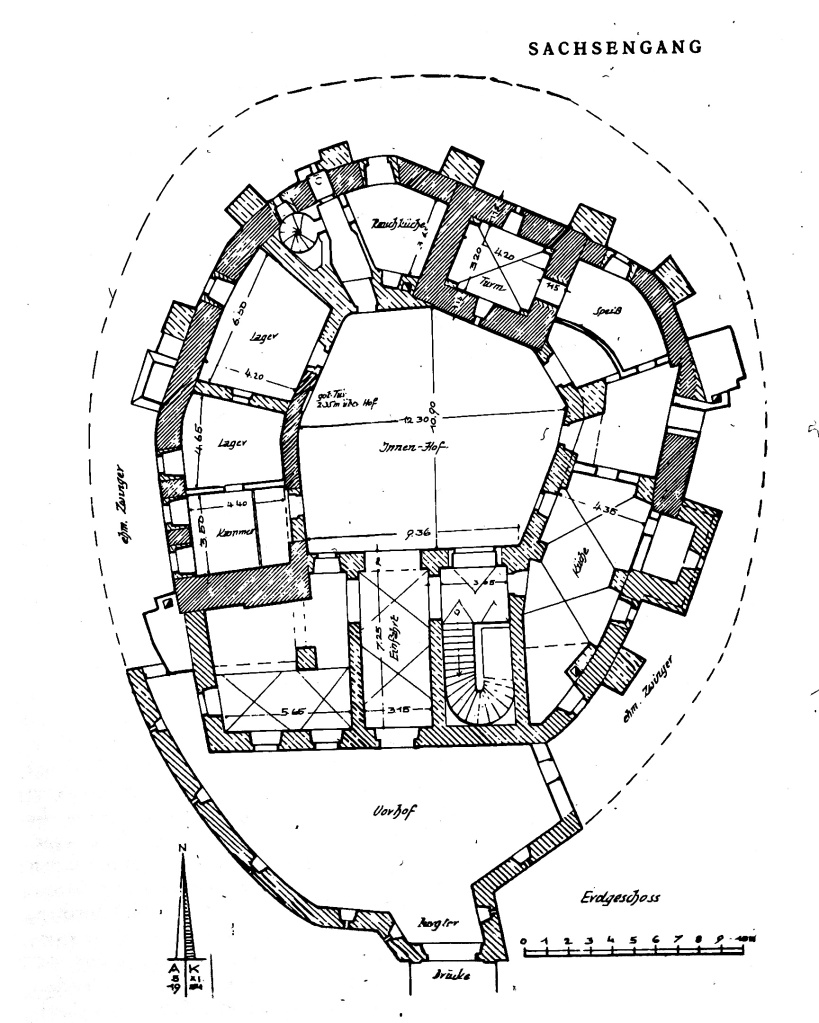Back in autumn 2021, my wife and I went on a battlefield walk following the French advance into the area east of Lobau island on 5th July 1809 – the preparatory movements for the battle of Wagram.
Our last stop was Schloss Sachsengang, a small little castle that served as the last point of defense for a couple of companies of Austrian Jäger. I always wanted to make a small ladder campaign out of the whole action, but of course I would need the castle to play the final scenario. During the last weeks, I finally built the model!
Castle Sachsengang was built at the beginning of the 12th century. It was placed on a motte surrounded by a moat. The basic layout is polygonal with three towers, of which one is still standing. As was the case with all such structures, it was heavily modified over time. I could not find any images depicting the situation around 1800, so I used written descriptions from participants in the battle as well as photographs of today’s appearance.

The castle proper has large outbuildings to its northern side (which can be seen in the Vischer engraving on the right), which I didn’t include in the model so as to make it more versatile. I will use buildings I already have to depict those.
The castle itself is very small – the courtyard is only about 10m across and the whole structure is no wider than 30m. I still decided to scale it down from the figures scale, that is, not use a scale of 1:100 but one of 1:160 for the layout. In my games, I usually assume that one figure actually represents a couple of guys and reducing the footprint allows me to bring more of the surroundings on the table, making the scenario more interesting.
I luckily found a layout plan in a book, so I printed it out in the desired scale and glued it on a sheet of foamboard, which would form the motte. I built the structure out of the sturdy cardboard I have come to love, which is called “Finnpappe” (“finnish cardboard”) in Austria. For the walls, I use 3mm thick sheets, which are astonishingly easy to cut but very sturdy and not prone to warping. It fulfills the same function as foamcore at a tenth of the price. The windows are 3D-printed, the doors are scratch built. The patches of stonework are cut out of a foil I had lying around – they will look like the are behind the plaster when the surface structure is applied.
The first challenge was how to paint the castle. Normally, I finish the whole structure and then just paint it. However, with this, I knew I would not be able to paint the walls and windows of the walls facing the courtyard as the space was too cramped. So I decided to built it in three pieces, paint them separately and then glue them together. Before painting, I coated them with filler to give them a plaster-like structure.

I then assembled the painted pieces and touched up any gaps with filler.
The next challenge was the roof. The polygonal layout makes it rather difficult to calculate the shape of the roof segments, which I usually do. So I just played it by ear and fitted them with a process of measuring and trial and error. I used 1mm thick sheets of the cardboard for this. This was easier than I thought and in the end I think it looks quite ok.

The final challenge was tiling the roof. As I do most of the time, I used tiny rectangles of cardboard and applied them piece for piece. I like the effect it gives more than that of the readily-available roofing material, which is also incredibly expensive. However, roof tiling in this way is a lengthy and mind-numbing process that can’t be done in one go, so it took me a week or so to finish it.

The last and more enjoyable step was modelling the base with the moat. I used 3mm thick plywood for the base, which incidentally led to a couple of funny (in hindsight) moments when I put the whole thing (base with castle glued on) on my commode and realised that the base had warped badly! Panicking, I asked my mates Sigur and Virago what to do and we discussed all kinds of tricks to straighten the plywood. However, when I had organised some screw clamps and proceeded to clamp the structure to my gaming table, I realised that magically, the warping had gone. Turns out the the surface of my commode is uneven…!
Anyway, I built up the outer banks of the moat with foamboard and filler and proceeded to painting the base. Originally, I wanted to use water effect for the moat, but then I thought that it would add height and make it look too flat in relation to the banks, so I just applied several layers of gloss varnish. (Also, I’m a bit afraid of water effects since I had some large cracks in a swamp I made, ruining the whole effect).
So, this is it: Schloss Sachsengang ready for gaming! Apart from the Hanslgrund scenario, I also want to use in for a fictional campaign I’m preparing at the moment. But more on this some other time.





































